best point and shoot camera low light

Best Point and Shoot camera 2021
If you're shopping for a point-and-shoot compact camera, you've come to the right place! At Camera Labs I write in-depth reviews of cameras but understand you're busy people who sometimes just want recommendations of the most outstanding products. So here I'll cut to the chase and list the best point-and-shoot cameras around right now. Note like my other guides they're also listed by review date, not in order of preference.
Check prices at Amazon, B&H, Adorama, eBay or Wex. Alternatively get yourself a copy of my In Camera book or treat me to a coffee! Thanks!Best Point and Shoot
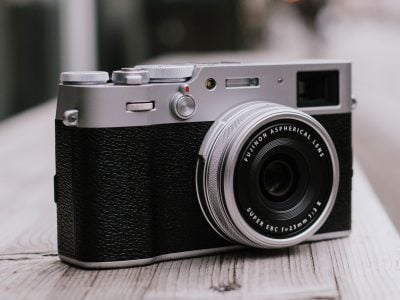
With its fifth generation, the Fujifilm X100V finally fulfils the ambition and promise of the original concept. Since day-one back in 2010 it's delivered one of Fujifilm's X-Trans sensors in an attractive compact and retro-styled body with a fixed lens, hybrid viewfinder and virtually silent leaf shutter, but while this was enough to attract a passionate following with street photographers, earlier models disappointed in other respects, most notably with a soft lens at close range and lack of weather-sealing; I also personally felt it could be further improved with a tilting screen. The X100V resolves almost all of this while adding more besides. The redesigned lens now delivers satisfyingly crisp results near and far, the screen can tilt, the body's now weather-sealed, and the X100V also throws in most of the video capabilities of the X-T30 including 4k. There are of course some caveats. The lens isn't optically stabilised, nor is there sensor-based or electronic stabilisation either - this isn't a deal-breaker for stills, but video shooters will need to find a way to steady it. The extending lens requires the optional filter adapter for the camera to become weather-sealed and right now the built-in ND filter isn't available for video use. And like the X-T30, the longest video clip length is a fairly modest 10 minutes for 4k or 15 in 1080. I should add my X100V also became very warm in prolonged use, especially when filming 4k video, although in my own tests it never shut down due to overheating. Ultimately the upgrades on the X100V have transformed it into a very flexible camera that can successfully turn its hand to many subjects and situations. On a personal note, I also felt an emotional connection with the camera for the first time, and absolutely loved shooting with it. The X100's evolving journey may have taken ten years to get to where we are now, but the X100V has now become my favourite fixed lens compact camera to date and one I can Highly Recommend.
Check prices on the Fujifilm X100V at B&H, Adorama, or Wex. Alternatively get yourself a copy of my In Camera book or treat me to a coffee! Thanks!
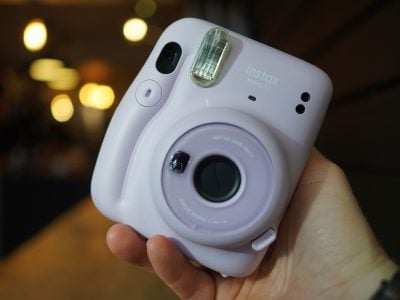
The INSTAX Mini 11 is a no-brainer if you're after a low-cost instant camera, but I'd say the biggest decision is whether to go for it or one of Fujifilm's INSTAX Square models. The INSTAX SQ6, looking like a giant Instagram logo, costs about half as much again, but outputs noticeably bigger square prints that are more reminiscent of classic polaroids. They're the same height as the Mini format, but wider and it makes a surprising difference. I personally prefer the INSTAX square format, and you can check out my INSTAX SQ6 review if you'd like to find out more. Or if you prefer to print photos from your phone - or indeed any pictures you've copied onto it - check out the INSTAX Mini Link portable printer; I hope they produce a square version of that one soon. In the meantime though if you're after the most capable budget instant camera, the Mini 11 takes the crown.
Check prices on the INSTAX Mini 11 at Amazon, B&H, or Wex. Alternatively get yourself a copy of my In Camera book or treat me to a coffee! Thanks!
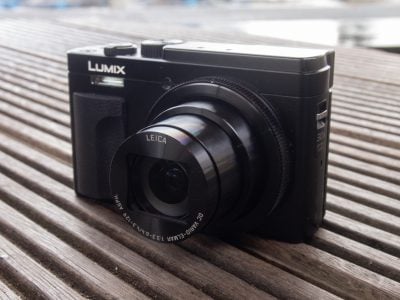
With a 30x stabilised zoom, 3 inch LCD screen, 2.3 million dot viewfinder, 4k video, Wifi and Bluetooth, the Panasonic Lumix TZ95 / ZS80 is the pocket travel zoom others seek to emulate. Nikon has come within a whisker with the COOLPIX A1000 which, aside from a less detailed viewfinder, closely matches the TZ95 / ZS80's hardware spec and manages to squeeze-in a slightly longer 35x zoom. Despite that, the TZ95 / ZS80 feels like a more sophisticated camera all round. But with only the upgraded viewfinder and Bluetooth separating it from the older TZ90 / ZS70, that's now looking to be a real bargain, so keep a close-eye on prices. If you're after the best of the current crop of pocket super-zooms though, the Lumix TZ95 / ZS80 is the one to beat.
Check prices on the Lumix TZ95 / ZS80 at Amazon, B&H, Adorama, or Wex. Alternatively get yourself a copy of my In Camera book or treat me to a coffee! Thanks!
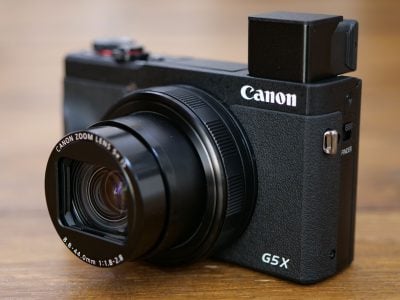
The Canon PowerShot G5X Mark II is a powerful compact camera with a 20 Megapixel 1in sensor, 5x / 24-120mm zoom, popup viewfinder, tilting touchscreen, fast bursts and 4k video. Canon's made a U-turn on design, swapping the chunkier DSLR-styling of its predecessor for something more pocketable and more akin to Sony's RX100 series. So it's out with the fixed viewfinder hump and side-hinged screen for a popup viewfinder and vertically-tilting display. The grip has shrunk and the front dial lost, but there's still more to hold onto than the RX100 and the changes have allowed the G5X to become much more pocketable than before. This does however bring it closer to the G7X III with Canon essentially asking you to choose between the popup viewfinder and slightly longer 5x zoom of the G5X versus the mic input and Live Streaming of the G7X III. Couldn't we just have it all in one body instead, or perhaps do identical versions, with and without viewfinders to meet different price points? There's also tough competition from Sony's RX100 VA which gives you the popup viewfinder, tilting screen, 4k video and fast bursts, but with the benefit of more responsive phase-detect autofocus for photos and video, although in its favour the G5X II zooms almost twice as long while also sporting a touchscreen and better grip. Overall the G5X II loses much of what made its predecessor unique in the 1in market, and leaves anyone desiring a mini DSLR-styled compact to aim for the G1X Mark III instead. But by aligning it more closely to its best-selling rival, the G5X II becomes more attractive to a bigger audience. Imagine how much more popular it could have been merged with the G7X III's connectivity.
Check prices on the Canon PowerShot G5X II at B&H, Adorama or WEX. Alternatively get yourself a copy of my In Camera book or treat me to a coffee! Thanks!
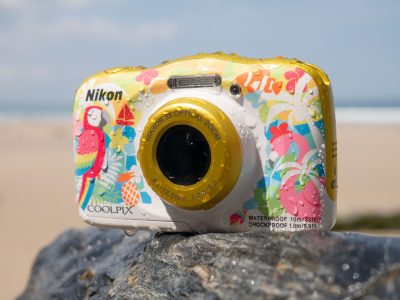
The Nikon COOLPIX W150 is an inexpensive, easy to use and fun waterproof compact that's aimed at families and active kids. It's fully automatic, has a 3x optical zoom and of course is waterproof, bounce-proof and freeze-proof. Apart from great design and simplicity of operation, its main strength is that it can send photos to your phone over a Bluetooth connection while you shoot. It lacks optical stabilisation, has a small, low resolution screen, has only one 1080/30p video mode and isn't great at continuous shooting; so it may not be very sophisticated, but what it does, it does very well. Also, it can bark like a dog or tweet like a bird when you press the shutter, which in many people's eyes (and I include myself among them) will more than make up for those shortcomings. The W150 does however represent a very minor update over the previous W100, with the only new feature being an Underwater Face Framing mode. So it's well worth comparing prices against the older Nikon COOLPIX W100. Whichever version you end up with though will delight families with active kids who can all relax regardless of who's using the camera and where they're using it.
Check prices on the Nikon COOLPIX W150 at Amazon, B&H, Adorama, or WEX. Alternatively get yourself a copy of my In Camera book or treat me to a coffee! Thanks!
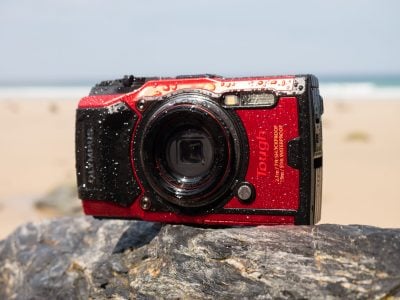
The Olympus TOUGH TG-6 is a modest update to the earlier TG-5, with a higher resolution 1040k dot screen and new anti-glare glass in front of the sensor. The quality of underwater photos and video have been improved by the addition of three new white balance modes for differing water depths and the microscope macro mode can now be used under water. So a minor update, but over what was already arguably the best rugged waterproof camera around, which makes the TG-6 top dog – there's nothing to match its bright f2 lens, superb image quality, speedy continuous shooting and wealth of video modes including 4K. I'm highly recommending it because of its unmatched performance in and out of the water. But one thing it's not is cheap, so if you're on a budget check out the older TOUGH TG-5, the Fujifilm Finepix XP140 or Panasonic's Lumix FT7. Meanwhile if you're after something cheaper for active kids, check out Nikon's COOLPIX W150.
Check prices on the Olympus TOUGH TG-6 at Amazon, B&H, Adorama or WEX. Alternatively get yourself a copy of my In Camera book or treat me to a coffee! Thanks!
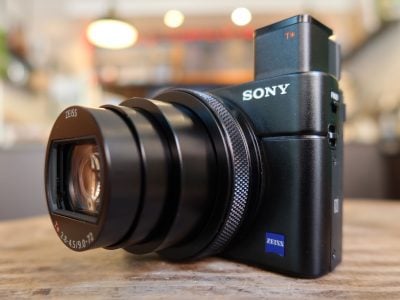
The Sony RX100 VII is a high-end compact designed for travel, action, video and vlogging. Successor to the RX100 VI, it shares the same 24-200mm f2.8-4.5 zoom as well as essentially the same body with a touch-screen that can angle up to face you and small but detailed viewfinder that pops up and pushes back down again in a convenient single action. New to the RX100 VII is a faster sensor, allowing it to shoot long bursts up to 20fps without blackout, coupled with Sony's latest autofocus and eye detection tracking for both humans and animals, so while it's technically a tad slower than the 24fps top speed of the Mark VI, it's more usable and ideal for capturing sports as well as active kids and pets. If you feel the need for greater speed though, a new single burst mode fires seven frames at up to 90fps, but in the absence of pre-buffering, your timing will need to be perfect. The best quality movie modes remain in 4k at 24, 25 or 30p, but are now enhanced by eye-detection, more effective stabilisation and the presence of a 3.5mm microphone input - a rarity in this type of camera, although without an accessory shoe you'll ideally need a bracket or a lav mic. As before it's up against tough competition from Canon's G5X II and G7X III which both sport 4k video, brighter lenses with ND filters and flip screens while also undercutting it on price; the G5X II also has a viewfinder while the G7X III sports a mic input. But the Sony zooms much longer, boasts phase-detect AF that's more confident whether you're shooting stills or video, not to mention much quicker bursts and higher frame rates for super slow motion. That said, much of what makes the Mark VII compelling is available in the older RX100 VI if you don't need the mic input, improved 4k stabilisation or latest AF modes, so keep an eye on prices, while dedicated vloggers may still prefer the earlier RX100 VA which has a shorter but brighter lens with an ND filter, albeit no mic input. Ultimately though if you're after a do-it-all pocket travel camera that's also great for video and action, the RX100 VII is hard to beat. It's not cheap, but there's nothing else that offers all of this and still fits in your pocket.
Check prices on the Sony RX100 VII at B&H or WEX. Alternatively get yourself a copy of my In Camera book or treat me to a coffee! Thanks!
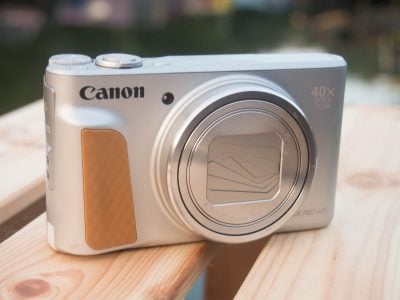
The Canon Powershot SX740 HS is a pocket super-zoom with a 20 Megapixel sensor and a huge 40X zoom range extending from 24 - 960mm. If it's the longest zoom in a pocketable compact you're looking for, you won't be disappointed. The SX740 HS offers PASM exposure modes, fast 10fps continuous shooting, 4k video, and has a flip up screen that's great for selfie shooting. On the downside, the 4k video involves a tight crop that may make the effective telephoto reach even longer, but makes the short-end much less wide than when filming in 1080p. To be fair the same restriction applies to the Lumix TZ90 / ZS70 and overall the SX40 HS provides a good balance between simplicity and sophistication for those who like a little bit of control, but are equally happy relying on Auto. Recommended, but also consider its main rival the Lumix TZ90 / ZS70 which may have a slightly shorter range, but offers more physical controls, a touch screen, RAW support and a built-in viewfinder, all for a roughly similar price thanks to being an older model. It's also worth remembering if you don't need 4k video or the 10fps bursts, Canon's previous SX730 HS offers much the same features at a slightly lower price while stocks last.
Check prices on the Canon SX740 HS at Amazon, B&H, Adorama, or Wex. Alternatively get yourself a copy of my In Camera book or treat me to a coffee! Thanks!
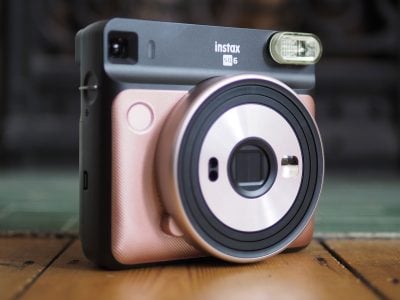
The Fujifilm Instax SQ6 is an analogue instant camera styled to look like the classic Instagram logo. It's Fujifilm's second instant camera to use the Instax Square format, but unlike the earlier digital SQ10 it employs the simpler analogue process of the popular Instax Mini series. This makes it cheaper and while the lack of a sensor and internal storage means there's no way to print duplicate images nor view them on a screen first, many fans of the analogue system prefer its ephemeral nature as each print is literally unique. In a nice upgrade over the Instax Mini 9, there's the choice of three focusing ranges (thereby increasing the chance of a sharp image) and while the exposure remains automatic, the camera now has access to range of shutter speeds allowing it to better-handle bright scenes; the SQ6 is also supplied with three coloured filters for the flash to produce special effects. Ultimately the SQ6 brings the attractive Instax Square format to a broader audience with a more affordable body, not to mention one that shares the analogue charm of the best-selling Minis with just enough frills to increase the chance of a successful print. Some of these frills may have been seen before on the Mini 90 Neo models, but for much the same body price you can now enjoy them deployed with the larger square format. Budget seekers may still seek out the cheaper Mini 9, but I reckon the SQ6 is worth the extra for its greater sophistication plus the chance to use the square format. Recommended.
Check prices on the Fujifilm Instax SQ6 at Amazon, B&H, Adorama, or Wex. Alternatively get yourself a copy of my In Camera book or treat me to a coffee! Thanks!
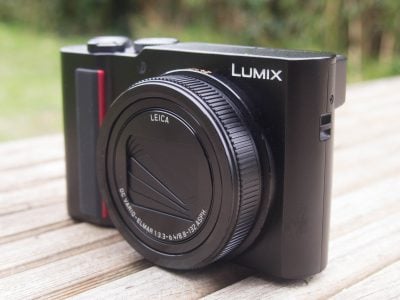
Panasonic's Lumix TZ200 / ZS200 is the new top model in its enormously popular travel-zoom series. Successor to the TZ100 / ZS100, it inherits the 1in / 20 Megapixel sensor, built-in viewfinder, non-tilting touchscreen, 4k video and Wifi, but boosts the earlier 10x zoom range to 15x, increases the viewfinder detail, adds 1080 video at 120p for slow motion, and now includes Bluetooth for seamless connectivity and location-tagging. The literally big news though remains that new 15x zoom range, equivalent to 24-360mm and easily out-gunning not just its predecessor, but all rival 1in compacts with pocket bodies. The only compromise is an aperture that's become even dimmer at f3.3-6.4 versus the f2.8-5.9 of its predecessor, which in turn was already a lot dimmer than the f1.8-2.8 of rivals with shorter zooms. But that's the compromise you have to weigh-up. If you want a 1in sensor with a big zoom that's also bright, you'll need a much bigger body like the Sony RX10 or Lumix FZ2000. Ultimately for many photographers, the TZ200 / ZS200's combination of a big zoom and decent sensor in a pocket body is all they need to know: the lens range and feature-set are unbeatable in its class and like its predecessor it comes highly recommended.
Check prices at Amazon, B&H, Adorama, or Wex. Alternatively get yourself a copy of my In Camera book or treat me to a coffee! Thanks!
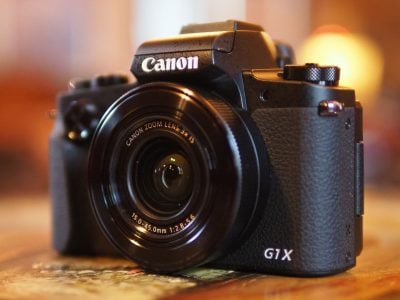
The Canon G1X Mark III is a unique camera, squeezing a large APSC sensor - the same found in the EOS 80D and EOS M5 models - into a relatively compact weatherproof body with a 3x optical zoom, built-in viewfinder, fully-articulated touchscreen, plenty of manual control and excellent wireless capabilities. The sensor also boasts Dual Pixel CMOS AF, allowing it to smoothly and confidently refocus for stills or movies. These all make the G1X Mark III one of the most powerful compacts to date, but there's still no 4k video, nor microphone input, and the big sensor also makes it one of the most expensive compacts around. Revealingly its rivals with smaller 1in sensors typically couple them with brighter lenses, allowing them to roughly match the G1X Mark III on resolution, noise and potential for background blurring, but there's no arguing with the APSC sensor's superior dynamic range, allowing the G1X Mark III to capture a greater tonal range and more saturated colours. Don't underestimate the appeal of squeezing the photo and movie quality of the EOS 80D into a compact weatherproof body weighing less than 400g either. The G1X Mark III may have some annoying omissions for movie shooters, but remains one of Canon's most compelling compacts appealing as a standalone camera or a companion to larger DSLRs.
Check prices on the Canon G1 X Mark III at Amazon, B&H, Adorama, or Wex. Alternatively get yourself a copy of my In Camera book or treat me to a coffee! Thanks!
best point and shoot camera low light
Source: https://www.cameralabs.com/best-point-and-shoot/
Posted by: humphreyhunty1956.blogspot.com

0 Response to "best point and shoot camera low light"
Post a Comment